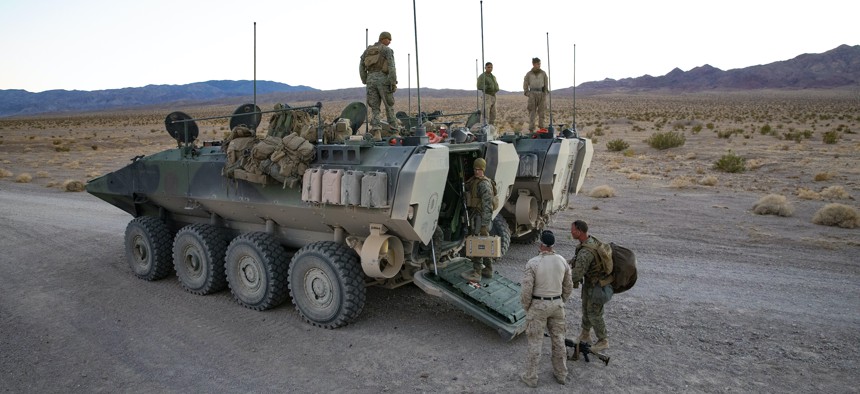
U.S. Marines with 3rd Assault Amphibian Battalion and 2nd Battalion, 7th Marine Regiment, 1st Marine Division begin unloading an Amphibious Combat Vehicle at the start of Marine Air Ground Task Force Warfighting Exercise 2-21 at Marine Corps Air Ground Combat Center, Twentynine Palms, Calif., Feb. 14, 2021. U.S. Marine Corps / Sgt. Courtney G. White
Marine Amphibious Combat Vehicles Returning to the Water
A tow mechanism problem led to a three-month suspension from waterborne operations.
The Marine Corps has developed a fix to a mechanical towing problem that has kept their Amphibious Combat Vehicles out of the water for months, officials announced recently.
The Corps suspended waterborne operations of the vehicles in September after Marines reviewing after-action reports from the field found a problem with the vehicle’s sea tow quick-release mechanism.
“In operations of the ACV, Marines reported they either could not actuate the quick release or the tow rope detached unexpectedly,” Marine Corps spokesman Maj. Jim Stenger said at the time.
Each of the vehicles can move 13 Marines plus three crew members from a ship to the shore.
This was the first suspension for the new ACVs, which were built to replace the aging Amphibious Assault Vehicles. An AAV sank in July 2020 during a pre-deployment training exercise off the California coast, killing eight Marines and a sailor. AAVs were suspended from water training for about nine months after that accident, and the service recently announced they will stop using those vehicles for scheduled deployments or water operations.
The service announced Jan. 6 that it developed a solution to address the ACV’s problem: an updated tow rope made of different material.
“The new rope has significantly more elasticity, which greatly improves the ability to manage peak loads experienced while towing,” Barbara Hamby, a spokeswoman for the Marine Corps' Program Executive Officer Land Systems office, said Monday.
Before heading out into open waters, units will have to install the new tow ropes and be trained on how to use them, the Marine Corps said. ACV units will start receiving the equipment this month, and all units are expected to have the new equipment and training completed by April, Hamby said. Future ACVs sent to the Marine Corps will also have the new tow rope and training.
ACV units will also have to certify on 18 tasks before returning to waterborne operations, to include vehicle inspections and qualifications for crewmembers, which were put in place after the deadly AAV incident.
“Amphibious operations, including the use of amphibious ship-to-shore connectors, is a foundational aspect of Marine Corps operations, and is critical to the future force and its ability to remain the nation’s premier expeditionary force in readiness,” Lt. Gen. David Furness, the deputy commandant for plans, policies, and operations, said in the Jan. 6 prepared statement.




